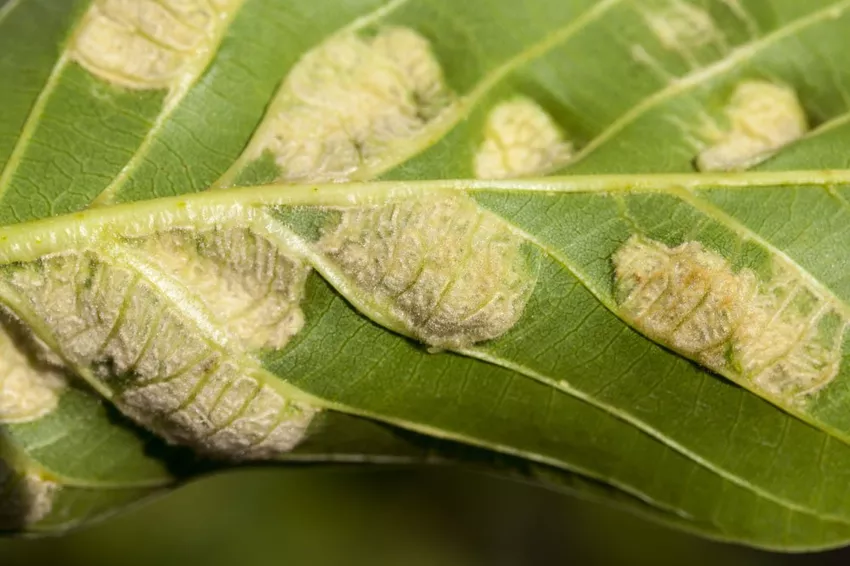Hardly any plant can be permanently protected from diseases and pests, not even the walnut tree. Although it is quite robust, various pathogens can attack it.
 Many trees and plants have natural protection against pests. So does the walnut tree. While human noses find the smell of the tree pleasant, it repels pests relatively reliably. But even the best natural protection doesn't mean your walnut won't get sick.
Many trees and plants have natural protection against pests. So does the walnut tree. While human noses find the smell of the tree pleasant, it repels pests relatively reliably. But even the best natural protection doesn't mean your walnut won't get sick.
In this article we explain how you can recognize diseases or pests and what you can do about them.
Common pests on walnut trees
Some pests are not deterred by the smell of the walnut tree. Gall mites, mealybugs and aphids, but also caterpillars sometimes settle in the tree. Another troublemaker is the walnut fruit fly, worthy of its name.
Aphids
 Aphids, which are among the sucking pests, are increasingly found on the underside of leaves. As a rule, you do not have to act immediately when you discover the lice. You should only take the following measures if the infestation is severe and many leaves are curling up:
Aphids, which are among the sucking pests, are increasingly found on the underside of leaves. As a rule, you do not have to act immediately when you discover the lice. You should only take the following measures if the infestation is severe and many leaves are curling up:
- Remove affected shoots
- In the case of a lower infestation: spray the lice directly with nettle manure. Alternatively, you can use natural pesticides made from potash soap, pyretrum and rapeseed oil.
- If the infestation is severe, chemical agents are recommended - but be careful: the walnuts are then no longer suitable for consumption.
A good way not only to contain aphid infestation, but to prevent it, is to use natural predators of aphids. Settle parasitic wasps, ladybugs or lacewings in your garden. Although the insects need an environment that suits their species, they not only protect your walnut tree, but also many other plants in the garden.
Foliar damage on the walnut
Butterfly caterpillars, blue sieve caterpillars and willow borer caterpillars sometimes settle on walnut trees. Again, try biological control of the caterpillars first. If the tree has not yet grown large, you can certainly take the caterpillars with youhands.
Blue Caterpillars
Blue worms are pests that can massively damage the walnut tree. The insects eat through the bark and leave tunnels in trunks and branches. You can recognize the blue screen caterpillars by their yellowish-white body, which is covered with point warts. The caterpillar can grow up to six centimeters long. To fight them, the following way is recommended:
- Remove any affected shoots.
- If the caterpillar has already established itself in the trunk, the tree should be felled.
Walnut Fruit Fly
Another pest that attacks the tree is the walnut fruit fly. You can recognize the pest primarily by the damage it leaves behind: black dots on the still green skins of the fruit. The maggot of the fruit fly penetrates the pericarp and slowly eats it, leaving it soft and moist.
» Combat Tip: Collect and destroy all infected fruit.
Prevention makes more sense, of course. Yellow boards, such as this one, simply hang up in different places in the tree and accordingly keep the walnut fly away. An alternative, but more cumbersome, is to tie down the tree with a fly net.
Diseases on walnut trees
It is not always easy to recognize which disease is hidden behind a symptom. We therefore recommend that you consult a specialist in advance and take specific action if in doubt.
Cherry Leaf Roll Virus
The cherry leaf roll virus is one of the diseases of a walnut tree that cannot be controlled. The virus causes spots to appear on both fruit and leaves, developing a line pattern.
Mildew
 Powdery mildew forms light-colored areas on the undersides of the leaves that have a mealy touch. Carefully remove the shoots and treat with pesticides. Look out for remedies based on night sulfur or organic substances. If possible, apply the remedy once a year before flowering.
Powdery mildew forms light-colored areas on the undersides of the leaves that have a mealy touch. Carefully remove the shoots and treat with pesticides. Look out for remedies based on night sulfur or organic substances. If possible, apply the remedy once a year before flowering.
Fungal Infections
Brown and grey-brown leaves indicate fungi. If you lift the leaves, you can partially see fruiting bodies on the underside. The diseases are particularly common in humid summers. As part of the fight, remove the affected parts of the plant again. There are no special pesticides in this case.
Bacteria
Form upGrowths on shoots are often caused by bacterial infestation. To prevent the bacteria from penetrating, you should regularly check the walnut tree for damage and keep freshly damaged areas clean. Even after the tree has been cut, bacterial infestation can occur at the cut points. Therefore, dry the cut edge carefully.